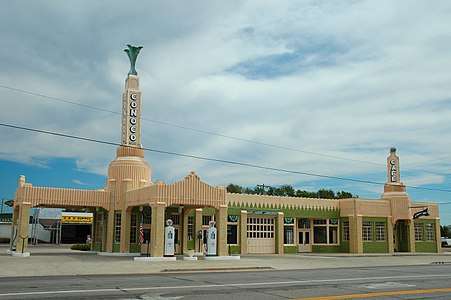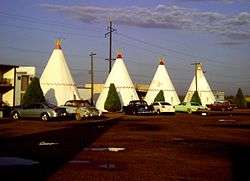Radiator Springs
Radiator Springs is a fictional town in the Cars series created as a composite of multiple real places on historic U.S. Route 66 from Chicago to Los Angeles. It appears in the 2006 Pixar film Cars and the associated franchise, as well as a section of the Disney California Adventure theme park.
Vicinity

The setting for the town of Radiator Springs is situated 87 miles from the state border of California, Nevada and 43 miles from Utah. Radiator Springs' position in relation to I-40, as shown on a map during a flashback in the 2006 film, is similar to that of Peach Springs on Arizona State Route 66.
The village is a composite of multiple locations; before making the film, Pixar sent a group of fifteen artists with Carburetor County sheriff and Oklahoma historian Michael Wallis as guide to take photos, talk to Route 66 people and learn the history of tiny towns along more than 1200 miles of road through five states.[1] In one restaurant, John Lasseter ordered one of every item on the menu for the Pixar group and spent four hours talking to the owner, absorbing information on the efforts to rebuild the historic byway to its neon-lit heyday.[2]
Lasseter told film critic Joe Williams of the St. Louis Post-Dispatch that much of the story is based on the recollections of barber Angel Delgadillo in the Route 66 town of Seligman, Arizona, where business withered soon after the opening of I-40.
Much of the film is based on research trips to visit automakers and NASCAR tracks in the United States.
Flo's V8 café is designed to look like a V8 engine head on, with a circular air filter, tappet covers, spark plugs, pistons and connecting rods as the supports for the shelter. The blinking neon lights on the spark plugs blink in the firing order of a Ford flathead V8.[3]
Route 66

Many characters and places in the film are directly inspired by real Route 66 places and people.[4]
To quote the Pixar crew:
- "As we traveled on Route 66, we were privileged to visit many places and to meet a number of people who live and work alongside 'The Mother Road'. The following is a list of the places and people we wanted to honor by including their names in our 'Special Thanks' credits at the end of the film."[5]
Among the many references to Route 66 landmarks and personalities:
- The Cozy Cone Motel's design is based on the two Wigwam Motels along Route 66, in Holbrook, Arizona and Rialto, California. These were once two out of seven built motels, with individual cabins shaped like teepees. Three Wigwam Motels remain; the third (and oldest) is in Cave City, Kentucky, far from Route 66. The recently restored Tee Pee Motel in Wharton, Texas, south of Houston, is of similar design but unrelated. The name "Cozy Cone" was inspired by the Cozy Dog Drive-In of Springfield, Illinois, which lays claim to being the birthplace of the corn dog.
- The character "Fillmore", referring to the famous San Francisco music venue The Fillmore, was at one time to be named "Waldmire" after Bob Waldmire, a self-proclaimed hippie artist known to Rt. 66 fans for his detailed pen-and-ink maps and postcards of the route. Though Waldmire's family owns the Cozy Dog Drive-In, Bob, having since become a vegan, preferred not to see his name put on a character that would become a McDonald's Happy Meal toy.
- Ramone's House of Body Art is based primarily on the U-Drop Inn in Shamrock, Texas. It opened in 1936 as Tower Conoco (from its distinctive Art Deco spire) with the U-Drop Inn Cafe and a retail building attached. Many other establishments built along Route 66 in its heyday had Art Deco elements that might be reflected in the design of Ramone's.
- The mountain is Tucumcari Mountain in Tucumcari, New Mexico with the hand-painted 'T' replaced by 'RS' for Radiator Springs. The neon "100% Refrigerated Air" on the Cozy Cone Motel is a reference to the Blue Swallow Motel in Tucumcari.
- Lizzie's Curio Shop in Radiator Springs resembles the Route 66 jumble of memorabilia and knick-knacks at Hackberry General Store in Hackberry, Arizona and the Sand Hills Curiosity Shop, aka the City Meat Market building in Erick, Oklahoma. The yellow billboard for Lizzie's Curio Shop reading "HERE IT IS" with an image of a Model T is based on the Jack Rabbit Trading Post signage in Joseph City, Arizona.
- Sheriff is voiced by Michael Wallis, an American historian and author of Route 66: The Mother Road.
- The characters "Flo" and "Sally" are based on Fran Houser of the Midpoint Café[6] and Dawn Welch of the Rock Café[7] respectively.
- The bridge that McQueen sees Sally driving on resembles several bridges on Route 66, including the Cyrus Avery Route 66 Memorial Bridge in Tulsa, the Colorado Street Bridge in Pasadena, California, and the now-closed bridge over Diablo Canyon at Two Guns, Arizona.
- The character Tex Dinoco isn't a Route 66 resident, but was inspired by the Cadillacs horns at The Big Texan Steak Ranch.
- Part of the inspiration for Mater was Dean Walker of the Route 66 Association. He is known as the "Crazy Backwards Walker"; he can twist his feet and walk backwards. Another inspiration for Mater was the 1951 tow truck, now owned by CARS on the ROUTE.
The epilogue shows a map of the area of Arizona around Radiator Springs, including car-related place names such as "Carburetor County" and "Cadillac Range". The latter is a large north-to-south mountain range with many fin-backed jagged peaks, a reference to the famous Cadillac Ranch sculpture in Amarillo, Texas. Where the main road crosses the Cadillac Range is marked "Tailfin Pass 5942" (i.e. feet altitude, = 1.8111 kilometers).
Continuity
There are a few sights of the front page of a newspaper named The Daily Exhaust, which serves primarily as a vehicle to explain the NASCAR history behind the Fabulous Hudson Hornet of the early 1950s.
During the 2006 film's closing credits, the characters are at a drive-in watching clips of the Pixar films "Toy Car Story" (Toy Story), "Monster Trucks, Inc." (Monsters, Inc.) and A Bug's Life ("Bug" as in Volkswagen Beetle), whose characters have been rendered as vehicles in the style of Cars. Mack the red Mack Super-Liner comments that "they're just using the same actor over and over", an in-joke referring to John Ratzenberger, who voiced Mack and characters featured in the clips. The cinema itself is similar in design to an NRHP-listed 66 Drive-In in Carthage, Missouri, but without the later addition of widescreen and FM radio.
The group of small birds from the 2000 Pixar short film For the Birds made a cameo appearance in Cars. As Mack is en route to California at 17:44 in the film, the group of small birds can briefly be seen (and heard) sitting on their familiar telephone wire. In addition, the Pizza Planet truck from Toy Story also makes a cameo outside of the race track, at the final race in the movie.[8]
Other settings
The rail grade crossing at which Lightning McQueen outruns a freight train on his way to Radiator Springs is protected by a pair of antique "upper-quadrant" wigwag crossing signals which accurately depict those once made by the Magnetic Signal Company in both appearance and start-up. Few are left in actual operation in the United States, and many have been replaced with modern crossing gates, red lights and bells.
"Ornament Valley" is a reference to Monument Valley. This is not on Route 66, but is a side trip in northern Arizona. Willy's Butte resembles the landmark of Mexican Hat, Utah, but also resembles a classic Pontiac hood ornament.
The track on which the opening race (Motor Speedway of the South) takes place is based on an enlarged version of Bristol Motor Speedway.[9] The venue for the Piston Cup tiebreaker race (the Los Angeles International Speedway) is a conglomeration of the Los Angeles Memorial Coliseum, the Arroyo Seco in Pasadena where the Rose Bowl is located, as well as the Auto Club Speedway in Fontana.
The sign "City of Emeryville – Closed for the race" is a nod to Pixar's headquarters in Emeryville, California in the San Francisco Bay Area.
References
- CARPENTER, ERIC. "Life changed at her café when Pixar dropped in".
- "Dawn Welch, the Little Blue Porsche". Outlook - Edmond and North OKC Oklahoma Magazine.
- Dan Neil (June 4, 2006). "A grease geek will guide you: Cars decoded". Los Angeles Times. Retrieved November 1, 2006.
- Ron Warnick (June 9, 2006). "A Route 66 guide to the Cars movie". Route 66 News. Retrieved March 16, 2013.
- Ron Warnick (June 13, 2006). "Pixar's Route 66 inspirations". Route 66 News. Retrieved June 2, 2009.
- Eric Carpenter (June 13, 2012). "Life changed at her café when Pixar dropped in: Fran Houser said her Route 66 Midpoint Café in Texas was a sleepy spot – until the "Cars" movie premiered". Orange County Register.
- David Hanigar (August 2006). "Dawn Welch, the Little Blue Porsche". Edmond Outlook. Cite journal requires
|journal=(help) - Cars (DVD). Disney/Pixar. 2007.
- Mike Snider (June 15, 2006). "'Cars' touts a real-life look". USA Today. Retrieved September 1, 2012.
External links
| Wikivoyage has a travel guide for Radiator Springs. |